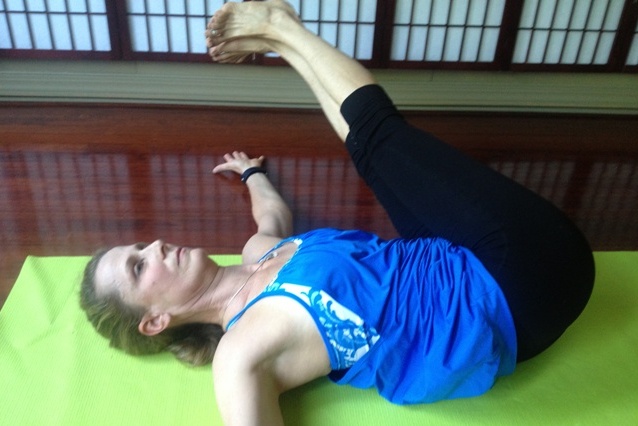This clicking noise often happens when you twist. Twisting involves rotation of the spinal vertebrae. Each vertebrae has a couple of degrees of possible rotation. The vertebra in the neck have the most movement at an average of 7.9 degrees for each vertebra. The thoracic vertebrae average only 2.9 degrees each. The lumbar vertebrae have the least amount of rotation at approximately 1 degree each.*
Each vertebra touches the vertebrae directly above and below it with a part called the articular facet. There are four of these parts, two on the upper part of the vertebra and two on the lower part. These facets help keep the vertebrae aligned. (There are also many muscles and ligaments that keep the vertebrae aligned, so there is no danger of them slipping entirely out of place!) But in certain twisting actions these facets can slip against each other making this clicking noise. I know I felt these same slight movements and heard these sounds and in my own body. While these sounds are relatively harmless when they happen occasionally, they are not something that should happen every time you twist.
It is important to not use a lot of leverage when you twist. The arms are used in most seated or standing twists and gravity is used in most supine twists. You need to be judicious in the use of the arms to let them add ease to the movement of the twist and in the engagement of the muscles rather than being aggressive in forcing the body to twist further. This over-rotating happens at certain vulnerable points in the spine, such as at the juncture of T-11 and T-12.
This is especially important in supine twists where gravity is pulling on the weight of the body. If the oblique muscles are not strong enough and you allow your body to drop over into the twist as opposed to lowering it into the twist, you can create a lot of shear force between the vertebrae and those facet joints will click against each other trying to hold the spine in good alignment. When twisting with gravilty, lower the body part slowly and with control. Make sure you are keeping your abdominal muscles engaged as you twist. For example, when you are lying on your back and twisting your legs to the right in Jathara Parivartanasana, as you lower your legs to the right, turn your navel to the left. If you only go as far as you can slowly and with abdominal control, and your opposite shoulder staying on the ground, you will find that your back no longer clicks. You also may be surprised that you don’t go very far! This is ok. Build your strength and range of motion over time. Flexibility without strength creates instability.
If you sit in an easy cross legged pose and rotate to the right, slowly without using your hands or arms, you may find that you do not go very far. This is the limit of your range of twisting using your muscles. Try twisting to the left to see if there is any difference between one side and the other. You probably don’t get that clicking noise when you do this upright twist. Take this knowledge and awareness into twists where you use your arms and/or gravity and twist mindfully.
There are two other things that are important in twisting, one is to keep your spine long and straight. You don’t want to increase the leverage on any given vertebra by bending it as you twist it. The other thing is to draw your belly button towards your spine and engage your muscles in the opposite direction of your twist.
You want to develop your core muscles in twisting and to only twist as far as you can go without that clicking noise. Your strength and range of motion can increase over time. Try these exercises and see if that stops or reduces the clicking in your spine. Let me know how it is working for you, or if you have any further questions by leaving your comments in the space below this post.
*Mel Robin, A Handbook for Yogasana Teachers: The Incorporation of Neuroscience, Physiology and Anatomy into the Practice.



